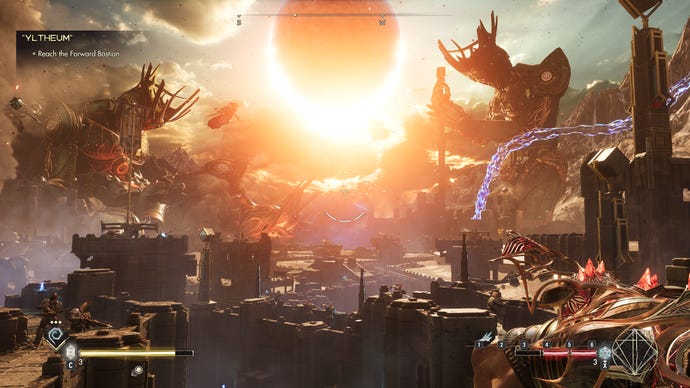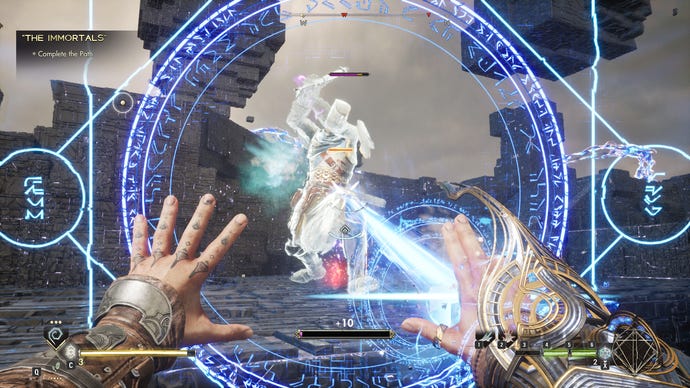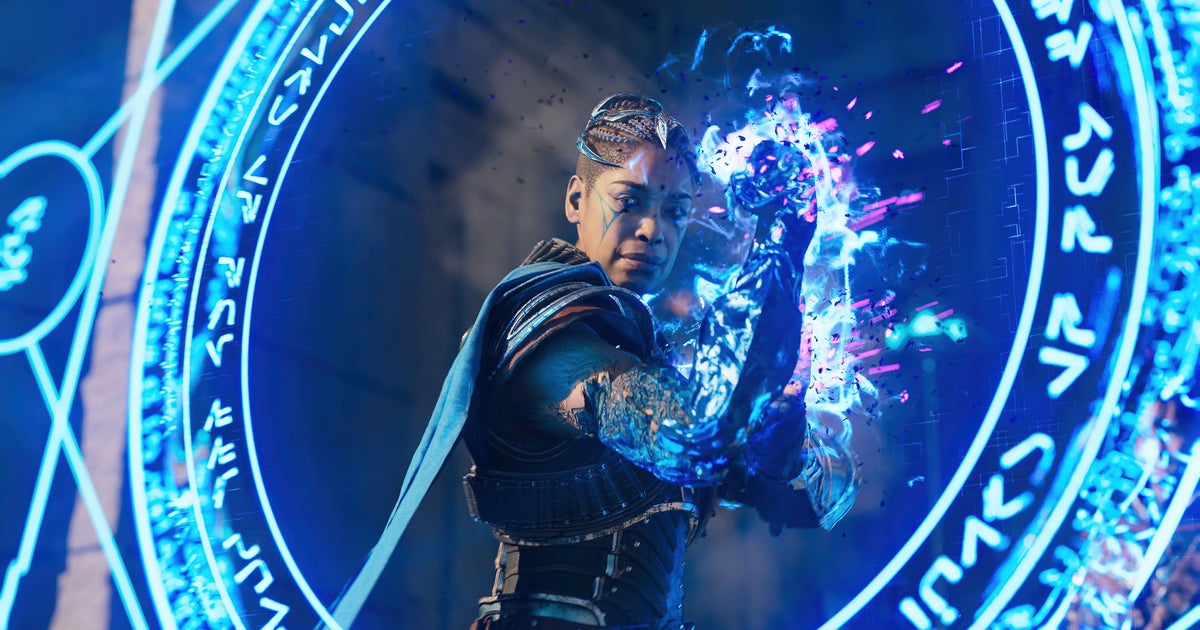Products You May Like
Immortals of Aveum is making me wonder whether there’s some kind of gigantic hidden market for floaty magic shooters with overcooked YA dialogue and exceedingly high PC hardware demands. After this and Forspoken releasing within a few months of each other, I’m half expecting Call Of Duty: Modern Warfare 3 to open with Captain Price shooting GPU-smelting laser beams out of his ‘tache.
Indeed, this first person sorcery adventure will be hell on your hardware, even if you’ve tooled up with a high-grade graphics card and CPU. This is somewhat more understandable than with the other low-performing PC games we’ve seen this year, as Immortals of Aveum is one of the first Unreal Engine 5.1 games, and makes extensive use of its sparkly new lighting and VFX tech. Sadly, it also aims so high that the only way to get playable performance on lower-end and older mid-range kit it to gut the quality settings.
DLSS and FSR 2 are on hand to help, but like Remnant II, Immortals of Aveum is tough enough to run that these upscalers feel like full necessities rather than optional tweaks. Still, after much testing across a range of setups, I think I’ve conjured up a settings guide that should help keep those framerates up.

A hint at the task at hand comes in Immortals of Aveum’s PC requirements, which are a joke almost as unfunny as the ones in its script. Hello, yes, it says here that Low-quality 1080p needs a GeForce RTX 2080 Super? And that an RTX 3080 Ti is only just good enough for 1440p when it’s paired with an AMD Ryzen 5700X? Is that not just a lengthy series of typos?
It is not, and although I’ve got Immortals of Aveum in a playable state on less luxury hardware (including the very much budget-friendly Intel Arc A750), this is ultimately an extremely demanding game that will leave a lot of older rigs behind. Here are the full specs:
Immortals of Aveum Low PC specs (1080p / 60fps)
- GPU: AMD Radeon RX 5700 XT / Nvidia GeForce RTX 2080 Super
- CPU: AMD Ryzen 7 3700X / Intel Core i7-9700
- RAM: 16GB
- OS: Windows 10 (Windows 11 recommended for Intel 12th and 13th Gen CPUs)
- Storage: 70GB (SSD recommended)
Immortals of Aveum Medium PC specs (1440p / 60fps)
- GPU: AMD Radeon RX 6800 XT / Nvidia GeForce RTX 3080 Ti
- CPU: AMD Ryzen 7 5700X / Intel Core i7-12700K
- RAM: 16GB
- OS: Windows 10 (Windows 11 recommended for Intel 12th and 13th Gen CPUs)
- Storage: 70GB (SSD recommended)
Immortals of Aveum High PC specs (4K / 60fps)
- GPU: AMD Radeon RX 7900 XT / Nvidia GeForce RTX 4080
- CPU: AMD Ryzen 7 5700X / Intel Core i7-12700K
- RAM: 16GB
- OS: Windows 10 (Windows 11 recommended for Intel 12th and 13th Gen CPUs)
- Storage: 70GB (SSD recommended)
Immortals of Aveum Ultra PC specs (4K / 120fps)
- GPU: AMD Radeon RX 7900 XTX / Nvidia GeForce RTX 4090
- CPU: AMD Ryzen 9 7950X3D / Intel Core i9-13900KS
- RAM: 16GB
- OS: Windows 10 (Windows 11 recommended for Intel 12th and 13th Gen CPUs)
- Storage: 70GB (SSD recommended)
A few hours with the RPS test PC suggests that these requirements are fairly accurate. Though the closest I could get to the minimum spec was a Core i5-11600K and an RTX 2080 Ti, some 1080p benchmark runs ended with all-Low settings producing 67fps and all-Ultra settings averaging 55fps. Weirdness of seeing a former flagship brought so low besides, these do point to the RTX 2080 Super getting around 60fps on lower settings (or Ultra with upscaling).
It was common to see other high-end graphics cards, even brand new ones, perform well below how they might in other AAA games. The RTX 3070 could only manage 56fps in Ultra-quality 1080p, and at 1440p, it needed DLSS on Balanced mode to get 67fps. Even the RTX 4070 Ti, which can handle most games at maxed-out 4K, could only squeeze 34fps out of native 1440p on Ultra quality. In fairness, this shot up to 64fps with Balanced DLSS, but that’s only a good result in a vacuum.
A lot of older PCs will miss out entirely. The GTX 1060 may still be popular in 2023 but it could not reliably keep Immortals of Aveum above 30fps at 1080p, even on all-Low settings and with FSR on Performance mode (the latter coming at a significant fidelity cost). The absolute most basic GPU you can probably get away with is the Intel Arc A750, or equivalent: this could stay above 30fps for 99% of the time, but needed Low settings and FSR on Balanced mode to do it.
Lastly, I tried the RTX 4060, hoping that its combination of newness and comparatively low pricing could make it a winner. Yet even this failed to take Ultra quality to a steady 60fps at 1080p, instead averaging 49fps. High settings did get it up to 57fps and Low to 67fps, but again, we can’t really say that these are “good” results. Most games don’t stress out a weeks-old, mid-range GPU to anywhere near this extent.

Does Immortals of Aveum at least look good? In some ways, yes: plenty of its wizard fights are filled with impressively dense, flamboyant magic effects. Unfortunately, these encounters can also be prone to additional performance problems, especially stuttering and even the occasional crash to desktop. I’ve also seen a few flickering shadows and textures, though these don’t seem as common following the day 1 patch.
Hopefully there’s a DLSS 3 fix in the works as well, but Immortals of Aveum has by far the worst implementation of its frame generation feature (currently exclusive to RTX 40-series cards) that I’ve ever seen. Usually, there are some imperfections in the AI-created frames that DLSS 3 slides between the ordinary rendered ones, but in ever other game, these are so small and are on screen for such little time that they’re essentially invisible. Here, on the other hand, the UI is plagued by flashing afterimages of incorrectly generated imagery.
It’s not just ugly but unplayable, as it makes the aiming reticule bounce from side to side whenever you move or look around. And, even if frame generation was visibly fine, Immortals of Aveum doesn’t let you enable it without enabling DLSS upscaling at the same time. This robs DLSS 3 of its flexibility, as 1080p would be ideal for enjoying the frames-per-second benefit of frame generation without a noticeable drop in sharpness that upscaling would impose. Other games recognise this and let you toggle the two component features separately, but Immortals of Aveum locks the two together.
Finally, playing on the Steam Deck is completely off the table. Even with every graphics setting on Low and FSR 2 on its fastest, most detail-deprived Ultra Performance mode, Valve’s handheld can’t stick to 30fps with any degree of consistency. It’s rated as Unsupported, per the official Steam Deck compatibility guide, for a reason.

Let’s say you’re not playing on a Steam Deck, but on a sufficiently meaty PC – you can at least trade some of the fancier visuals for better performance by chopping and changing Immortals of Aveum’s many individual graphics settings.
It’s a bit unusual in that it doesn’t offer the industry-standard choice of presets, though as I did for those benchmark results, you can manually switch the individual ones to Low, High, or Ultra. Like in a flatshare of introverted ghosts, there’s no medium here. There is, however, an interesting Performance Budget Tool, which analyses your hardware and sets a performance points budget for your CPU and graphics card. Every setting has its own points value – higher quality settings cost more, lower quality settings cost less – and the total of your currently selected configuration is compared to your hardware’s budgets, with a warning given if they’re exceeded.
It’s a neat idea and, if it worked perfectly, would probably save me a lot effort in making these guides. In practice, however, it just doesn’t help much, and following its Fantasy Football number-crunching as gospel will end up with you cutting settings you don’t need to cut. That’s because, despite the game’s generally low performance and the super-subtle visual differences between Ultra, High, and even Low qualities, a lot of these settings simply don’t affect performance much.
Attribution
Or at all, in the case of the RTX 4060, which I used – running at 1080p – to test them individually. Compared to its all-Ultra benchmark average of 49fps, the majority of settings didn’t add a single frame per second when I dropped each one to Low. The good news is that as long as you have a PC that can vaguely run Immortals of Aveum in the first place, you can leave these on Ultra with the knowledge that they’re not nearly as harmful as the Performance Budget Tool* suggests. The bad news is that you’re more limited in what you can change to speed things up.
(*For the record, while I did get stuttering and crashes while playing with my performance budgets in the red, I also got stuttering and crashes with settings that were well under budget as well. As well-intentioned as the tool is, then, don’t be discouraged if it seems like you’re spending too many points, as it can’t accurately predict the true point where your PC becomes overtaxed.)
In a break from RPS settings guide tradition, let’s make this one a tad simpler, first by listing all the settings that didn’t budge that 49fps average on the RTX 4060 when lowered. These are, in other words, the settings you can safely keep on High or Ultra:
- Texture quality
- Visual effects quality
- Shadow quality
- Post processing quality
- Volumetric fog quality
- Atmosphere quality
- Depth of field quality
- Foliage quality
- Light shafts (keep on)
- Local exposure (keep on)
- Mesh quality
- Motion blur quality (there’s no Off switch for this, unfortunately)
- Particle quality
- Subsurface scattering quality
- Mesh pool size
- Shadow rendering pool size
Next up, the settings worth changing. These also deserve some more individual explanation:
DLSS: Normally I’m loathe to suggest upscaling 1080p, but for Immortals of Aveum, some Nvidia GPUs may have no choice. Balanced mode looks workable enough and got the RTX 4060 up to 81fps, while the slightly sharper Quality mode produced 72fps. Both represent sizeable gains, so it’s always worth at least trying DLSS on cards that support it, especially at 1440p and above.
As for frame generation, which is available to RTX 40 series GPUs, leave it alone unless its UI-spoiling is fixed. It could be a useful tool – combined with Quality DLSS upscaling, it shoved the RTX 4060 up to 105fps – but the visual problems aren’t worth it for now.
FSR 2: An alternative to DLSS for AMD, Intel, and older Nvidia GPUs. Quality mode saw that 49fps average jump to 69fps, so it’s reasonably potent, if not as fast as DLSS. There’s also more visible aliasing and artefacting than on DLSS, so try not to drop below Quality unless you’re on a much older or less powerful PC.
Global illumination quality: Sacrificing some of Unreal Engine 5.1’s new lighting will grant a decent speed boost, up from 49fps to 56fps in the RTX 4060’s case. That’s what happened when I switched from Ultra to Low, and really, the visible quality difference is minor.
Reflection quality: A much smaller gain here, of just a single extra frame per second. Low quality produced a 50fps, which wouldn’t normally be worth bothering with, but for a game like Immortals of Aveum we need every frame we can scrounge.
Ambient occlusion quality: Likewise, dialling this down to Low only made for a 50fps average, but it’s better than nothing.
Anisotropic filtering: Turning this off entirely netted another 1fps improvement. Take what we can get, eh?
Ambient occlusion quality: Swapping Ultra for Low produced – you guessed it – 50fps, another frame for the bank.
Shadow mesh quality: Low, 50fps, again, I’m running out of ways to say this.
Shadow resolution quality: 52fps from Low! It’s not just a single frame this time! Sing to the heavens!
Render target pool size: Alright stop singing, we’re back to a 50fps result, this time by lowering the target pool size from 1000 to 200. This should hopefully help with stability as well.

So, the best settings for Immortals of Aveum are largely about scraping together tiny gains, with bigger boosts coming from just one or two high-impact changes. When you’re operating in the sub-60fps range, mind, those single frames can add up to make a meaningful difference. Here are my suggestions, in a more easy-to-read form:
- Global illumination quality: Low
- Reflection quality: Low
- Anisotropic filtering: Off
- Ambient occlusion quality: Low
- Shadow mesh quality: Low
- Shadow resolution quality: Low
- Render target pool size: 200
Without upscaling, these got the RTX 4060 up from 49fps to 63fps, almost matching the effects of dumping everything down to Low – but with loads of visual components still looking their best. Add DLSS on Balanced mode, which I also recommend, and that becomes an even slicker 88fps.
For those without DLSS capability, FSR 2 on Quality is a very good addition at 1440p or 4K, though see if you can get by without it at 1080p; the lack of sharpness compared to Nvidia’s upscaler is a lot more apparent at lower resolutions. That said, there’s no shame is turning it on anyway. Immortals of Aveum is evidently a PC-eating monster, and if FSR helps with the slaying process, so be it.
